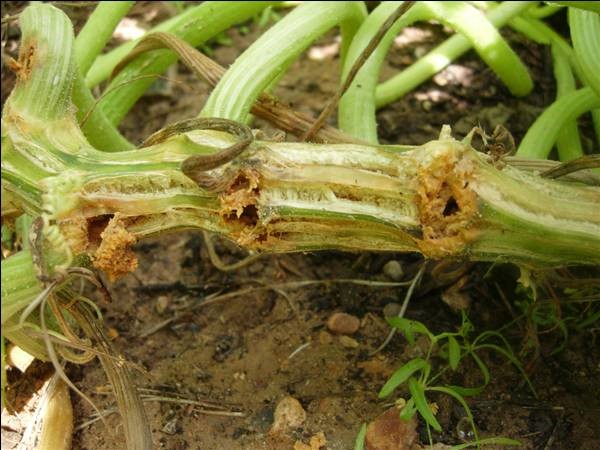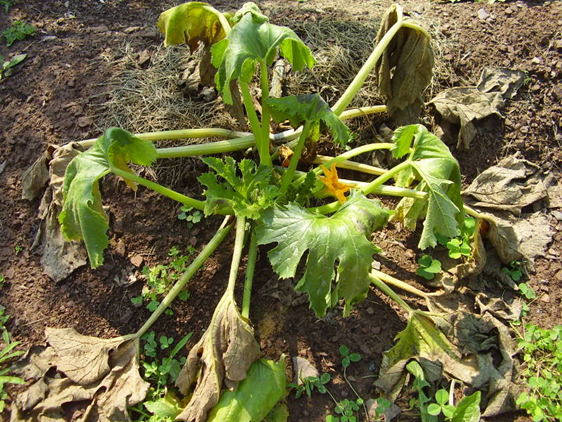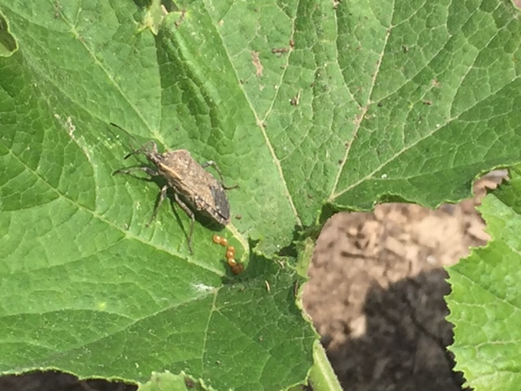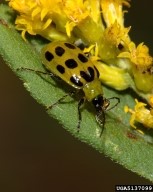
Why are my cucurbits wilting???

We have a lot of cucurbit crops in the ground producing or growing right now in Arkansas. These include squash, cucumber, watermelon, cantaloupe, and pumpkins. One thing I have noticed in most plantings is a wilted plant, or two, or three or if you are unlucky all of them. So what is causing your plants to wilt? It is probably one of these four things.
1) Lack of water
This is the easiest one to rule out. If you are not keeping up with the water demands of the plants they will wilt. Test the moisture level with advanced technology devices like your finger. You can scoop up a bit of soil in your hand if it forms a nice clump and sticks together, it is moist enough. If not, you need to water. They also make soil moisture probes if you need something a bit more high tech.


2) Squash Vine Borer
Oh the squash vine borer, it incites harsh words at the very mention of its name. If you have ever went out to notice all of your squash plants laid over by the slightest breeze, you have experienced the damage of the squash vine borer. You can see it is red and black and about the size of a red wasp.
They emerge May through August and lay eggs on the leaves and stems of plants. The eggs will hatch and the small larvae will crawl down the stems and chew into the stalks, which will leave a sawdust looking material called frass (insect poop) on the stems. They will feed inside and up the stems which causes the stems to weaken and often the plants will wilt and topple over. It is too late to control this pest once the larvae have burrowed into the stems of the plant. These guys prefer squash and pumpkin. I estimate that 20-40% of a large commercial planting with an infestation can be demolished without treatment. In a homeowner situation they will destroy everything.
You can monitor for adults beginning in May and I recommend beginning to treat when you catch adult moths in the traps. You can by moth bucket traps from many different suppliers and make sure to add a squash vine borer pheromone lure which will attract them to the trap. Monitoring has been found to be more successful in larger fields than smaller (3 acres or more).

For organic/homeowner control, you can apply a Bt product along with entomopathogenic
nematodes. These have been shown to work quite well. The trick is timing. You must
target the larvae right after they hatch from the eggs. If the larvae have burrowed
into the stems, it is too late to control with insecticide. A homeowner can also cut
the larvae out of the stem and the plant may survive to produce a decent crop. This
is not feasible for a commercial planting.
For commercial plantings I suggest spraying when plants begin to run on a weekly basis with a product like Mustang Max, Brigade, or Asana, if monitoring is not feasible. For a complete list of insecticides click here.
3) Squash Bug
This is the most difficult squash pest to control. This insect has needle like mouthparts that suck juices out of the leaves of the plant. While it is sucking, and man it really sucks, it injects a toxin into the plant that causes it to wilt and also the leaves will begin turning yellow and dying. You have to control this pest early or it is difficult to get under control. The nymphs, which are small versions of the adult without fully formed wings are much easier to control than the adults. Start monitoring for this pest soon after planting. The adults lay brown eggs on the plant. Sometimes they are clumped and sometimes they are random. If you have a few plants you can try to remove the eggs with a piece of duct tape and spray the adults with insecticidal soap, pyganic, carbaryl, or neem oil. If you have a commercial planting, it is best to put out a weekly spray. If you are managing for vine borer, the same products will work for squash bug and vice versa.



(Left) Wilted plant due to squash bug feeding, (middle) Squash bug adult laying eggs, (right) Squash bug eggs. (Photos: Jackie Lee)
4) Bacterial Wilt

So the ground is moist and you can find no sign of squash vine borer or squash vine bug. You more than likely have bacterial wilt. Bacterial wilt is a disease that is transmitted by the cucumber beetle. The cucumber beetle will feed on most all cucurbits and while feeding transmit the bacteria to the plant which causes severe wilting. Unfortunately when the plant has contracted this, there is nothing that can be done. Other beetles that feed on the infected plant will spread the disease throughout the planting. It is best to remove the plant and destroy it so that the disease cannot be transmitted to other plants. To correctly diagnosis bacterial wilt, it is best to get a plant sample to your local county agent to send in to the plant health clinic. You should bring the entire plant if the plant is showing wilting symptoms.
The only way to prevent bacterial wilt is to manage the spotted cucumber beetle. You will want to begin a management program for cucumber beetles, if they are present. Homeowners have few options that include pyganic, carbaryl, neem oil or insecticidal soap. For commercial plantings you can scout and begin spraying when the cucumber beetles average 1 per plant. For a list of registered insecticides consult our MP-144.
Plant resistant varieties and stagger plantings.
For all of these issues there are some varieties that are more resistant than others. It is important to utilize these less susceptible varieties when possible. Walthum butternut is less susceptible than other squash varieties to squash vine borer and cucumber beetle. Pumpkins that have powdery mildew resistance have been shown to be more susceptible to cucumber beetle and bacterial wilt.
There are also a few other things that can cause wilting. As always, consult with your local county agent if you have any questions. Also, always follow the pesticide label for instructions including restrictions, rates, and preharvest intervals.
Great description of tomato diseases from our plant diseases diagnostics lab, Sherrie Smith: